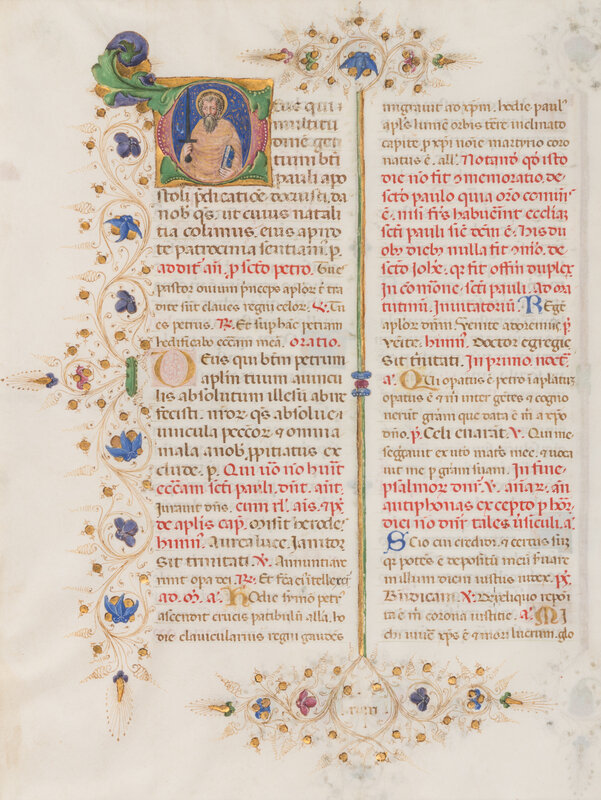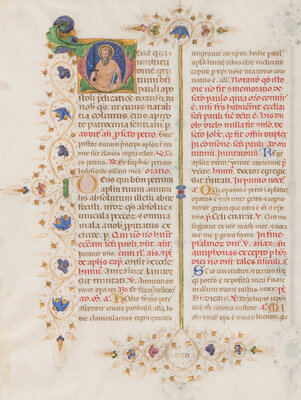Lot 26
GIORGIO D’ALEMAGNA AND CIRCLE (documented Ferrara, 1441-1462)
A leaf from the Breviary of Lionello d’Este, with a historiated initial ‘D’ of St. Paul, in Latin, illuminated manuscript on parchment [Italy, Ferrara, c. 1441-1448]
A leaf from the Breviary of Lionello d’Este, with a historiated initial ‘D’ of St. Paul, in Latin, illuminated manuscript on parchment [Italy, Ferrara, c. 1441-1448]
Sale 2033 - Western Manuscripts and Miniatures
Jun 27, 2024
10:00AM CT
Live / Chicago
Own a similar item?
Estimate
$4,000 -
5,000
Price Realized
$5,080
Sold prices are inclusive of Buyer’s Premium
Lot Description
GIORGIO D’ALEMAGNA AND CIRCLE (documented Ferrara, 1441-1462)
A leaf from the Breviary of Lionello d’Este, with a historiated initial ‘D’ of St. Paul, in Latin, illuminated manuscript on parchment [Italy, Ferrara, c. 1441-1448]
A leaf from the Breviary of Lionello d’Este, with a historiated initial ‘D’ of St. Paul, in Latin, illuminated manuscript on parchment [Italy, Ferrara, c. 1441-1448]
An example of a lavish ducal commission that represents the pinnacle of manuscript production in Ferrara at the height of the Renaissance.
245 x 185 mm (framed). Single leaf, ruled in lead for two columns of 30 lines (written space: 167 x 130 mm), written in a rounded late gothic bookhand in brown ink, capitals touched with yellow, rubrics in red, one-line initials alternately in blue or in burnished gold on yellow penwork, one two-line initials in burnished gold on a pink ground with white tracery, full-length middle bar-border of in burnished gold and green, extending into scrolling vine stems in the upper and lower margins with colored flowers and gold disks, enclosing catchword “[glo]riari” in lower margin, accompanied with an outer-sided border of scrolling vine stems with colored and burnished gold flowers and gold disks, ONE FIVE-LINE HISTORIATED INITIAL in pink and green on blue and burnished gold ground, with liquid gold highlights and white tracery, extending into a scroll of acanthus in the margin (light flakes in the ink, else in excellent condition). Framed.
This leaf comes from the Proper of Saints of the Breviary of Lionello d’Este, also known as the Llangatock Breviary (see below). It includes the Second Vespers of the Feast of St. Peter and St. Paul (29 June) on the recto, and the beginning of the Commemoration of St. Paul (30 June) on the verso, reading from “Deus qui…” to “et mori lucrum glo[riari].” The latter opens with a remarkable five-line historiated initial D for “Deus” that shows Saint Paul standing at half-length, brandishing his sword in his right hand, and bearing a large blue book in his left hand. He is depicted here with a full head of hair that distinguishes him from his usual portrayal as half-bald.
The Breviary originally comprised more than five hundred leaves and was created as a luxurious liturgical manuscript for Lionello d'Este (1407-1450), Marchese of Ferrara. Lionello was a wealthy patron of the arts, tied to such artists as Guarino da Verona, Leon Battista Alberti, Giovanni Bellini, Andrea Mantegna, and Pisanello. Archival records demonstrate that the book was commissioned from the artist Giorgio d’Alemagna and his assistants. Begun in 1441 and finished in 1448, the manuscript was copied by the scribe Francesco de Codigoro, with Giorgio d’Alemagna acting as its principal illuminator. In 1443, the enormity of the project resulted in the enlistment of Guglielmo Giraldi, Jacopo Magnanina, Matteo de’ Pasti, and Bartolomeo Benincà as assistants to the illumination.
The Llangattock Breviary demonstrates strong similarities with another work attributed to Giorgio d’Alemagna, the Missal of Borso d’Este (Modena, Bibliotheca Estense Universitaria, ms. a.W.5.2 = Lat. 239), illuminated between 1449 and 1457 for Lionello’s brother. The size, format, and illumination of the manuscript correspond to those of the Missal, suggesting that both manuscripts were most likely made for use in the ruler’s private chapel.
Provenance
Kenneth W. Rendell, Massachusetts.
Parent manuscript
The Llangatock Breviary was named after its nineteenth-century owner, John Etherington Wells Rolls (1807-1870), first Baron Llangatock, whose bookplate it carried, alongside inscriptions recording its acquisition after the Peninsular War in the early nineteenth century. The manuscript was sold as part of the library of his son John Allan Rolls (1870-1912), 2nd Baron Llangatock, at Christie’s, 8 December 1958, lot 190. It was then acquired by the Goodspeed Book Shop of Boston, who dismantled it and began to sell the leaves separately.
Sister leaves
The leaves of the Llangatock Breviary are now dispersed in public and private collections around the world. A virtual reunification has been proposed on the “Broken Books” website (brokenbooks.omeka.net), which records 115 leaves as of April 2024. The site is maintained by Debra Cashion, whose findings were first published in 2021. Some leaves are illuminated with historiated miniatures, in Paris (Musée du Louvre, Arts graphiques, RF 51871) and Cambridge, Mass. (Harvard University, Houghton Library, MS Typ 301). Further leaves are to be found, for instance, at U.C. Berkeley, the American Academy in Rome, Michigan State University, University of South Carolina, Dartmouth College, to cite but a few.
Two sister leaves are also included in this sale as lots 36a and 52.
LITERATURE
The present leaf has been described and published in: Kenneth W. Rendell, The Medieval World, 1979, Catalog 146, no. 141; Debra Cashion in The Burke Collection of Italian Manuscripts Paintings, ed. S. Hindman and F. Toniolo, 2021, no. 32, pp. 322-331, cited on p. 327; Debra Cashion, Broken Books website, cited and illustrated as “BB_Llang_0066”.
Other lots with leaves from the Llangattock Breviary in this sale are nos. 36a, 45, and 52
Freeman’s | Hindman thank Senior Consultant Sandra Hindman and Elliott Adam for their assistance in preparing this sale.
The Collection of Kenneth W. Rendell
Condition Report
Contact Information

